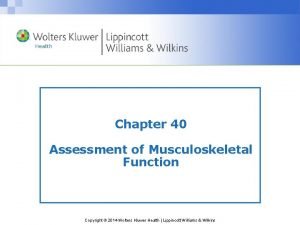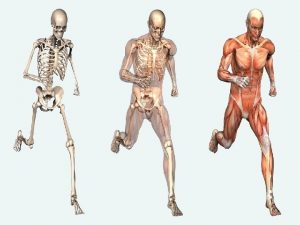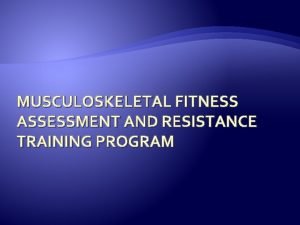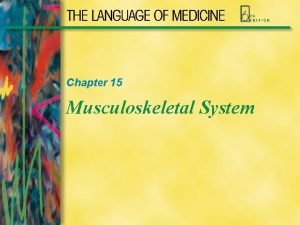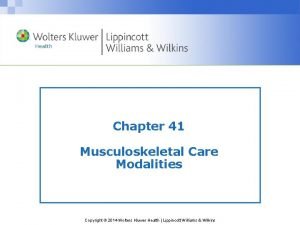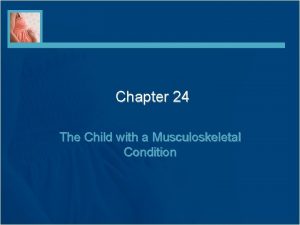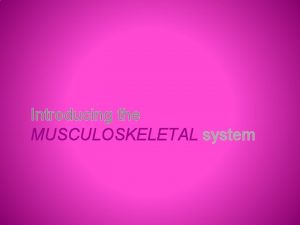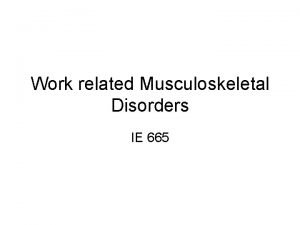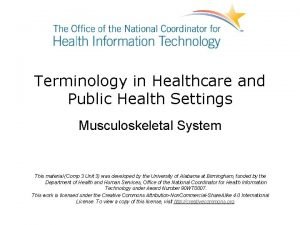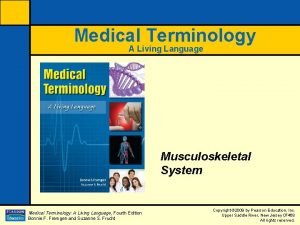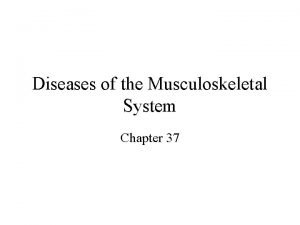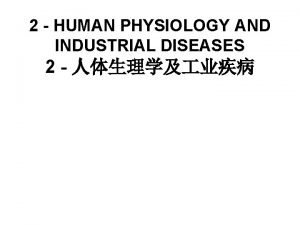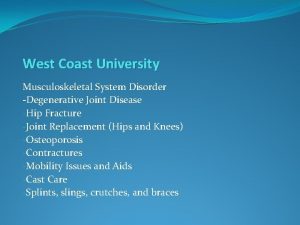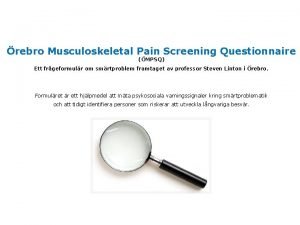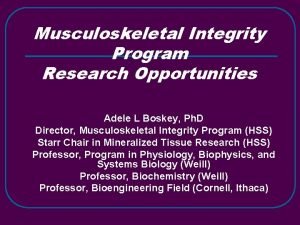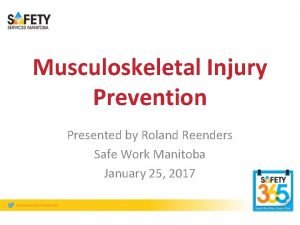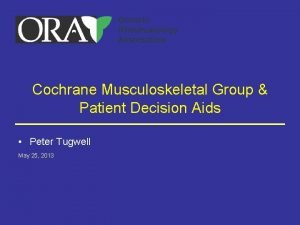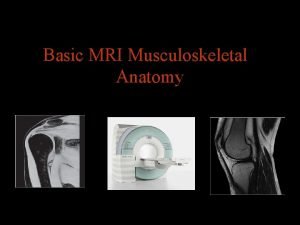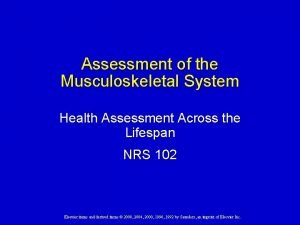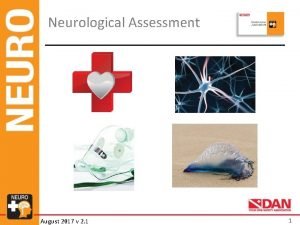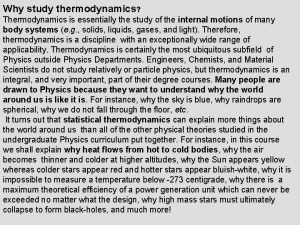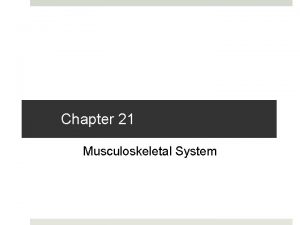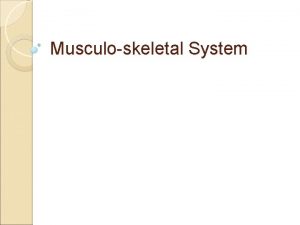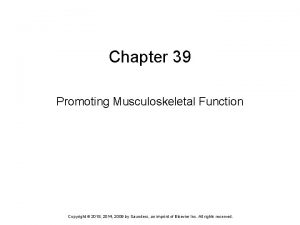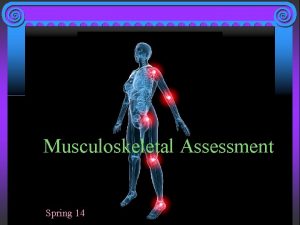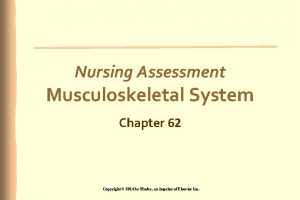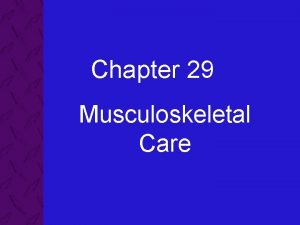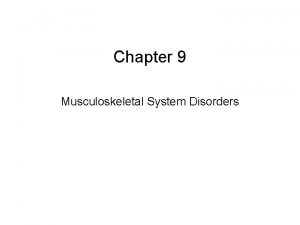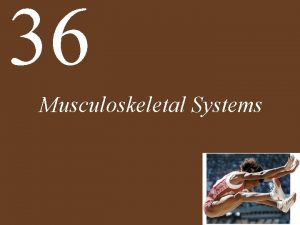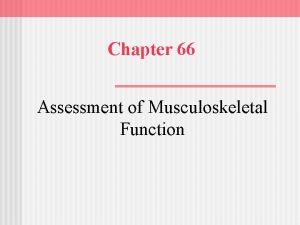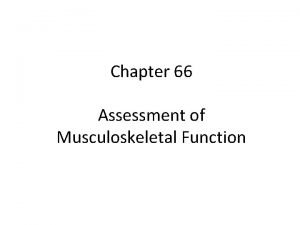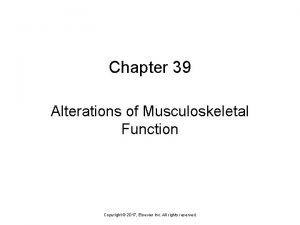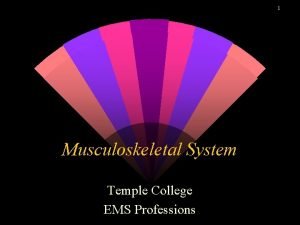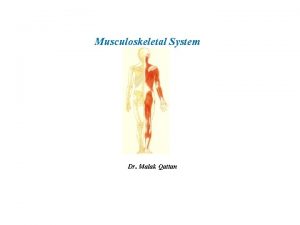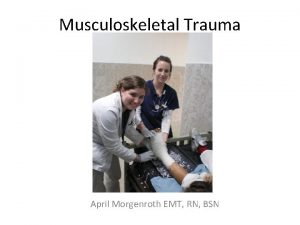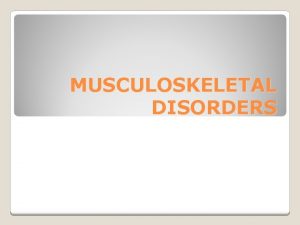Chapter 40 Assessment of Musculoskeletal Function Copyright 2014














































- Slides: 46

Chapter 40 Assessment of Musculoskeletal Function Copyright © 2014 Wolters Kluwer Health | Lippincott Williams & Wilkins

Question What is atrophy? A. Shrinkage-like decrease in the size of the muscle B. Fluid-filled sac found in connective tissue C. Rhythmic contraction of muscle D. Grating or crackling sound or sensation Copyright © 2014 Wolters Kluwer Health | Lippincott Williams & Wilkins

Answer A. Shrinkage-like decrease in the size of the muscle. Atrophy is shrinkage-like decrease in the size of the muscle. Bursa is a fluid-filled sac found in connective tissue. Clonus is rhythmic contraction of muscle. Crepitus is a grating or crackling sound or sensation. Copyright © 2014 Wolters Kluwer Health | Lippincott Williams & Wilkins

Functions of the Musculoskeletal System • Protection of vital organs • Mobility and movement • Facilitate return of blood to the heart • Production of blood cells (hematopoiesis) • Reservoir for immature blood cells • Reservoir for vital minerals Copyright © 2014 Wolters Kluwer Health | Lippincott Williams & Wilkins

Structure • 206 bones in the body – Long bones – Short bones – Flat bones – Irregular bones • Joints • Muscles Copyright © 2014 Wolters Kluwer Health | Lippincott Williams & Wilkins

Structure of a Long Bone; Composition of Compact Bone Copyright © 2014 Wolters Kluwer Health | Lippincott Williams & Wilkins

Bone Cells • Osteoblasts – Function in bone formation • Osteocytes – Mature bone cells that function in bone maintenance – Located in the lacunae • Osteoclasts – Multinuclear cells function in destroying, resorbing, and remodeling bone – Located in Howship’s lacunae Copyright © 2014 Wolters Kluwer Health | Lippincott Williams & Wilkins

Bone Formation and Maintenance • Osteogenesis: process of bone formation – Ossification: the process of formation of the bone matrix and deposition of minerals • Bone is in constant state of turnover • Regulating factors – Stress and weight bearing – Vitamin D – Parathyroid hormone and calcitonin – Blood supply • Role of calcium Copyright © 2014 Wolters Kluwer Health | Lippincott Williams & Wilkins

Bone Healing • Hematoma and inflammation • Angiogenesis and cartilage formation • Cartilage calcification • Cartilage removal • Bone formation • Remodeling Copyright © 2014 Wolters Kluwer Health | Lippincott Williams & Wilkins

Question Is the following statement true or false? Epiphysis is the bone-forming cell. Copyright © 2014 Wolters Kluwer Health | Lippincott Williams & Wilkins

Answer False Epiphysis is the end of a long bone. Osteoblast is a boneforming cell. Copyright © 2014 Wolters Kluwer Health | Lippincott Williams & Wilkins

Joints (Articulation): Junction of Two or More Bones • Synarthrosis: immovable joints • Amphiarthrosis: allow limited movement • Diarthrosis: freely movable – Ball and socket – Hinge – Saddle – Pivot – Gliding Copyright © 2014 Wolters Kluwer Health | Lippincott Williams & Wilkins

Hinge Joint of the Knee Copyright © 2014 Wolters Kluwer Health | Lippincott Williams & Wilkins

Muscles • Attached to bones and other structures by tendons • Encased in a fibrous tissue—fascia • Contraction of muscle causes movement • Sarcomere: the contractile unit of skeletal muscle that contains actin and myosin • Muscle cell fibers react to electrical stimulation • Contraction uses energy in the form of ATP • Anaerobic pathways using glucose metabolized from stored glycogen provide energy for more strenuous muscle activity Copyright © 2014 Wolters Kluwer Health | Lippincott Williams & Wilkins

Muscle Maintenance • Muscle tone • Muscle actions • Exercise, disuse, and repair Copyright © 2014 Wolters Kluwer Health | Lippincott Williams & Wilkins

Question Is the following statement true or false? Bone is in a constant state of turnover. Copyright © 2014 Wolters Kluwer Health | Lippincott Williams & Wilkins

Answer True Bone is in a constant state of turnover. Copyright © 2014 Wolters Kluwer Health | Lippincott Williams & Wilkins

Assessment of the Musculoskeletal System • Include data related to function ability; ADLs, IADLS, and ability to perform various activities; note any problems related to mobility • Health history: family history, general health maintenance, nutrition, occupation, learning needs, socioeconomic factors, and medications (include OTC) • Assessment of pain and altered sensations • Physical assessment: posture, gait, bone integrity, joint function, muscle strength and size, skin, neurovascular status Copyright © 2014 Wolters Kluwer Health | Lippincott Williams & Wilkins

Normal Spine and Three Abnormalities Copyright © 2014 Wolters Kluwer Health | Lippincott Williams & Wilkins

Detecting Fluid in the Knee Copyright © 2014 Wolters Kluwer Health | Lippincott Williams & Wilkins

Rheumatoid Arthritis—Ulnar Deviation and “Swan-Neck” Deformity Copyright © 2014 Wolters Kluwer Health | Lippincott Williams & Wilkins

Diagnostic Evaluation • Radiographs • Arthroscopy • Computed tomography • Arthrocentesis • MRI • Electromyography • Arthrography • Biopsy • Bone densitometry • Laboratory studies • Bone scan Copyright © 2014 Wolters Kluwer Health | Lippincott Williams & Wilkins

Copyright © 2014 Wolters Kluwer Health | Lippincott Williams & Wilkins

Copyright © 2014 Wolters Kluwer Health | Lippincott Williams & Wilkins

Copyright © 2014 Wolters Kluwer Health | Lippincott Williams & Wilkins

Copyright © 2014 Wolters Kluwer Health | Lippincott Williams & Wilkins

Copyright © 2014 Wolters Kluwer Health | Lippincott Williams & Wilkins

Copyright © 2014 Wolters Kluwer Health | Lippincott Williams & Wilkins

Copyright © 2014 Wolters Kluwer Health | Lippincott Williams & Wilkins

Copyright © 2014 Wolters Kluwer Health | Lippincott Williams & Wilkins

Copyright © 2014 Wolters Kluwer Health | Lippincott Williams & Wilkins

Copyright © 2014 Wolters Kluwer Health | Lippincott Williams & Wilkins

Copyright © 2014 Wolters Kluwer Health | Lippincott Williams & Wilkins

Copyright © 2014 Wolters Kluwer Health | Lippincott Williams & Wilkins

Copyright © 2014 Wolters Kluwer Health | Lippincott Williams & Wilkins

Copyright © 2014 Wolters Kluwer Health | Lippincott Williams & Wilkins

Copyright © 2014 Wolters Kluwer Health | Lippincott Williams & Wilkins

Copyright © 2014 Wolters Kluwer Health | Lippincott Williams & Wilkins

Copyright © 2014 Wolters Kluwer Health | Lippincott Williams & Wilkins

Copyright © 2014 Wolters Kluwer Health | Lippincott Williams & Wilkins

Copyright © 2014 Wolters Kluwer Health | Lippincott Williams & Wilkins

Copyright © 2014 Wolters Kluwer Health | Lippincott Williams & Wilkins

Copyright © 2014 Wolters Kluwer Health | Lippincott Williams & Wilkins

Copyright © 2014 Wolters Kluwer Health | Lippincott Williams & Wilkins

Question Which statement is false about magnetic resonance imaging? A. Credit cards with magnetic strips may be erased. B. Nonremovable cochlear implant devices can become inoperable. C. Transdermal patches that have a thin layer of aluminized back must be covered with gauze. D. Jewelry and hair clips must be removed before the MRI is performed. Copyright © 2014 Wolters Kluwer Health | Lippincott Williams & Wilkins

Answer C. Transdermal patches that have a thin layer of aluminized back must be covered with gauze. True statements are credit cards with magnetic strips may be erased. Nonremovable cochlear implant devices can become inoperable. Jewelry and hair clips must be removed before the MRI is performed. Transdermal patches that have a thin layer of aluminized back must be covered with gauze is false. Transdermal patches that have a thin layer of aluminized back must be removed before the MRI is performed because they can cause burns. Copyright © 2014 Wolters Kluwer Health | Lippincott Williams & Wilkins
 Assessment of the musculoskeletal system
Assessment of the musculoskeletal system Muscle strength scale
Muscle strength scale Musculoskeletal fitness test
Musculoskeletal fitness test 2014 pearson education inc
2014 pearson education inc Chapter 21 the musculoskeletal system
Chapter 21 the musculoskeletal system Chapter 6 musculoskeletal system diseases and disorders
Chapter 6 musculoskeletal system diseases and disorders Knuckle like process at the end of a bone
Knuckle like process at the end of a bone Chapter 41 musculoskeletal care modalities
Chapter 41 musculoskeletal care modalities Chapter 24 the child with a musculoskeletal condition
Chapter 24 the child with a musculoskeletal condition Caf pre assessment checklist
Caf pre assessment checklist Types of joint movement
Types of joint movement Unit 41 musculoskeletal system
Unit 41 musculoskeletal system Musculoskeletal system
Musculoskeletal system Musculoskeletal icd 10 codes
Musculoskeletal icd 10 codes Sakita 1m45
Sakita 1m45 Work related musculoskeletal disorders definition
Work related musculoskeletal disorders definition Musculoskeletal pronounce
Musculoskeletal pronounce Musculoskeletal system medical terminology
Musculoskeletal system medical terminology Diseases of the musculoskeletal system
Diseases of the musculoskeletal system Musculoskeletal system
Musculoskeletal system West coast musculoskeletal
West coast musculoskeletal ömpsq
ömpsq Subcostal retractions
Subcostal retractions Musculoskeletal integrity
Musculoskeletal integrity Musculoskeletal injury
Musculoskeletal injury Spine pathology
Spine pathology Musculoskeletal
Musculoskeletal Sathish srinivasan
Sathish srinivasan Cochrane musculoskeletal group
Cochrane musculoskeletal group Musculoskeletal mri anatomy
Musculoskeletal mri anatomy Objective data for musculoskeletal system
Objective data for musculoskeletal system Chapter 25 assessment of cardiovascular function
Chapter 25 assessment of cardiovascular function Chapter 10 chapter assessment chemical reactions answers
Chapter 10 chapter assessment chemical reactions answers Chapter 11 stoichiometry assessment answer key
Chapter 11 stoichiometry assessment answer key Chapter 9 chemical reactions test answers
Chapter 9 chemical reactions test answers Chapter 9 surface water answer key
Chapter 9 surface water answer key Chapter 2 representing motion assessment answers
Chapter 2 representing motion assessment answers Chemistry central science 14th edition
Chemistry central science 14th edition Chapter 2 chapter assessment
Chapter 2 chapter assessment Ionic compounds properties
Ionic compounds properties Chapter 7 chapter assessment ionic compounds and metals
Chapter 7 chapter assessment ionic compounds and metals Learning principle in portfolio assessment
Learning principle in portfolio assessment Define dynamic assessment
Define dynamic assessment Portfolio assessment matches assessment to teaching
Portfolio assessment matches assessment to teaching Motor function neurological assessment
Motor function neurological assessment Why study thermodynamics
Why study thermodynamics Rational functions parent function
Rational functions parent function
